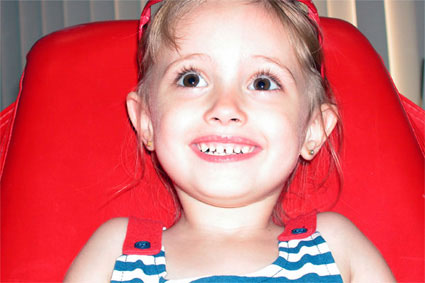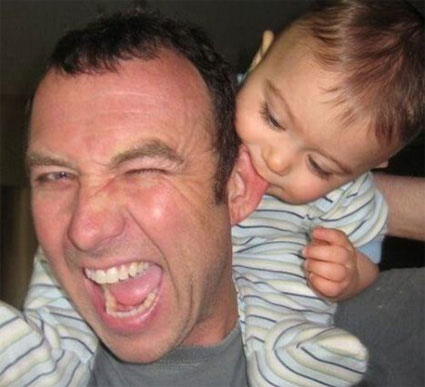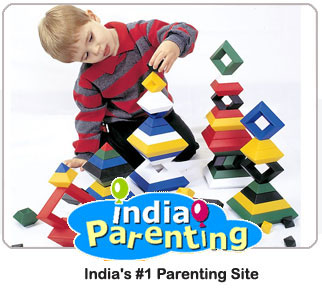In this articleWhat is baby bottle tooth decay?APPEARANCETHE PROCESSPREVENTIONWhat is baby bottle tooth decay? This is a very damaging type of decay and it affects a childs primary teeth or milk teeth. Various terms have been coined for this typical pattern of decay: Nursing Bottle Caries, Nursing Caries, Nursing Decay, Early Childhood Decay, Infant Caries, Milk Bottle Syndrome etc. Baby bottle tooth decay can be mainly attributed to an inappropriate feeding pattern. It requires special attention, and thus early recognition and intervention are essential to the successful treatment and prevention of the disease process. APPEARANCE The child suffering from nursing caries shows severely discoloured (black or brownish) or/and broken-down upper front teeth. The lower teeth are generally not affected as they remain covered by the tongue. Four factors which influence this typical decay pattern are: Teeth: The milk teeth start appearing at about 6 months of age. The teeth mainly affected are the upper incisors, first molars and canines in that order respectively as per their time of eruption and subsequent exposure to the foods. Bacteria: We know that various micro-organisms are present in the human oral cavity. The most important are the bacteria that appear in the mouth after the eruption of the first tooth. By itself, these micro-organisms cannot adhere to the tooth surface by themselves. They require plaque to assist them. Substrate: In addition to plaque, the bacteria and other micro-organisms need a substrate to thrive in the oral cavity. Substrate is found in baby foods, juices, milk formulas and other sweet items. Some babies are given pacifiers dipped in honey - excellent for the bacteria! Youve just answered their prayers! Time: The bacteria and the substrate need to be present for a long time in the mouth of the baby. If a child sleeps with his milk bottle in his mouth, the bacteria will have enough time to attack and wreak havoc. Thus, giving your child a milk bottle at bedtime is dangerous. Similarly, prolonged and unrestricted night-time breastfeeding also leads to bottle caries. THE PROCESS Heres how it works. You give your child a bottle at bedtime, so she can keep sucking till she goes off to sleep. Once your child is asleep with the bottle still in his mouth, the milk or the sugar beverage pools around the tooth and remains there for hours. Bacteria act upon the milk and cause the sugar to ferment. This brings about an acid formation which harms the tooth enamel, causing it to become weak and susceptible to decay. PREVENTION: Heres what you can do to prevent tooth decay: Infants should not be put to sleep with a bottle in their mouth. They should be burped before being put to bed. They should be held while feeding. They should be weaned from the bottle at 12 - 14 months of age. They should be encouraged to drink from a cup prior to their first birthday. Their diet should be supplemented with non-liquids, starting at 4-6 months of age. Oral hygiene should be started with the eruption of the first tooth. The first dental visit should be within 6 months after the first tooth appears.
What is baby bottle tooth decay?
This is a very damaging type of decay and it affects a child's primary teeth or milk teeth. Various terms have been coined for this typical pattern of decay: Nursing Bottle Caries, Nursing Caries, Nursing Decay, Early Childhood Decay, Infant Caries, Milk Bottle Syndrome etc.
Baby bottle tooth decay can be mainly attributed to an inappropriate feeding pattern. It requires special attention, and thus early recognition and intervention are essential to the successful treatment and prevention of the disease process.
APPEARANCE
The child suffering from nursing caries shows severely discoloured (black or brownish) or/and broken-down upper front teeth. The lower teeth are generally not affected as they remain covered by the tongue.
Four factors which influence this typical decay pattern are:
Teeth: The milk teeth start appearing at about 6 months of age. The teeth mainly affected are the upper incisors, first molars and canines in that order respectively as per their time of eruption and subsequent exposure to the foods.
Bacteria: We know that various micro-organisms are present in the human oral cavity. The most important are the bacteria that appear in the mouth after the eruption of the first tooth. By itself, these micro-organisms cannot adhere to the tooth surface by themselves. They require plaque to assist them.
Substrate: In addition to plaque, the bacteria and other micro-organisms need a 'substrate' to thrive in the oral cavity. Substrate is found in baby foods, juices, milk formulas and other sweet items. Some babies are given pacifiers dipped in honey - excellent for the bacteria! You've just answered their prayers!
Time: The bacteria and the substrate need to be present for a long time in the mouth of the baby. If a child sleeps with his milk bottle in his mouth, the bacteria will have enough time to attack and wreak havoc. Thus, giving your child a milk bottle at bedtime is dangerous. Similarly, prolonged and unrestricted night-time breastfeeding also leads to bottle caries.
THE PROCESS
Here's how it works. You give your child a bottle at bedtime, so she can keep sucking till she goes off to sleep. Once your child is asleep with the bottle still in his mouth, the milk or the sugar beverage pools around the tooth and remains there for hours. Bacteria act upon the milk and cause the sugar to ferment. This brings about an acid formation which harms the tooth enamel, causing it to become weak and susceptible to decay.
PREVENTION:
Here's what you can do to prevent tooth decay:
- Infants should not be put to sleep with a bottle in their mouth. They should be burped before being put to bed.
- They should be held while feeding.
- They should be weaned from the bottle at 12 - 14 months of age.
- They should be encouraged to drink from a cup prior to their first birthday.
- Their diet should be supplemented with non-liquids, starting at 4-6 months of age.
- Oral hygiene should be started with the eruption of the first tooth.
- The first dental visit should be within 6 months after the first tooth appears.
































